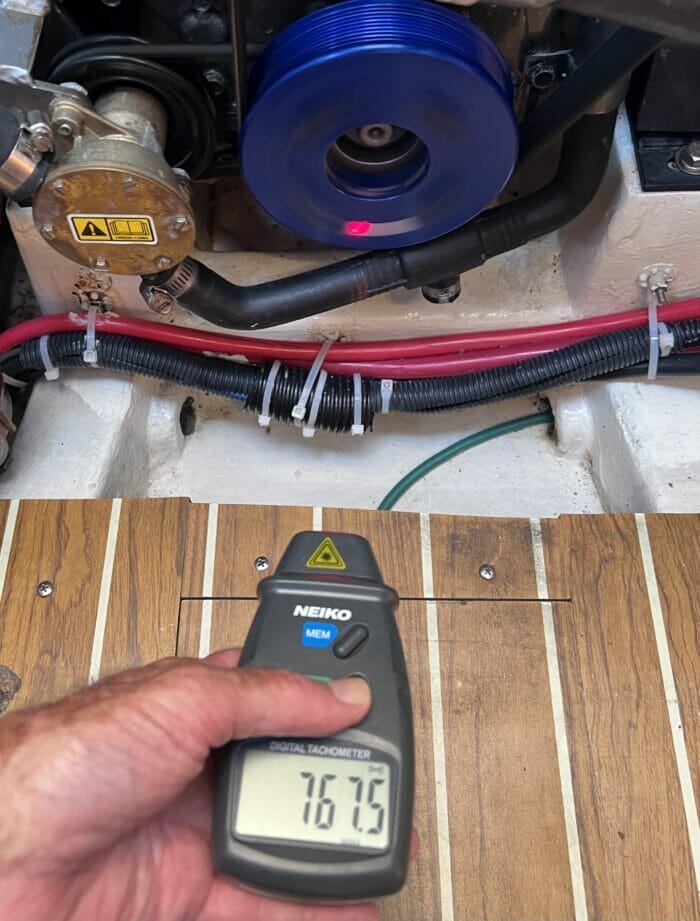
There are all kinds of good reasons to check our engine RPM, including making sure:
- We are not overloading before the engine warms up.
- We are not under-loading after warm up.
- To figure out fuel burn.
- To check that the prop is not under- or over-sized.
- To check that the engine has not lost RPM at wide-open throttle, an early sign of all kinds of things that should be fixed before damage is done.
But the problem is that tachometers can drift into inaccuracy.
And an even bigger problem is that if we change our alternator to a larger and more robust one, as many of us cruisers do, and most of us should, it’s likely that the tachometer will be wildly inaccurate afterward because the new alternator sends a different number of pulses per revolution.
Wait, there’s more. If we change to a serpentine belt, again as we should, that likely changes the ratio between the crank shaft and alternator RPM, making the inaccuracy even worse.
The good news is that handheld RPM counters are both accurate and relatively cheap.
And then once we know the actual RPM, it’s reasonably easy…OK, a pain in the ass…to recalibrate the tachometer.
Phyllis spent an hour crunched up in the cockpit locker poking at the little calibration button while I read the rapidly changing numbers and yelled “press”, “let go”, “press”.
Why an hour? Because I adjusted the wrong way…twice…but let’s not go there.
Worth it to have an accurate tachometer, though…at least as far as I’m concerned…not asking Phyllis.
You can usually find the calibration instructions for your tachometer online, but here’s a typical set of instructions.

I used an app on my phone. You paint a white line on the thing that is spinning. The app flashes your strobe, which you can speed up or slow down, and when the white line appears stationary the speed the strobe is flashing at is your rpm. Just use the words “tachometer” and “strobe” in the app search and you’ll find several options. There’s also some that say they use sound, but I didn’t try those.
Hi Courtney.
A good way to safe $50. That said I do like the direct read out of the dedicated tool.
I am concerned about Phyllis spending an hour crunched up in the cockpit locker: I did this in my lazarette and got a DVT (deep vein thrombosis) behind my knee. Four years later I unwisely stopped taking the “blood thinning” tablet and immediately developed a pulmonary embolism (a lung clot) which could have killed me and has stopped me sailing for five months. Come out of that locker every ten minutes Phyllis!
Hi Robin,
Thanks for your concern, and good point, that said, I did let her out several times! Seriously, sorry to hear of your experience. A sobering warning to all of us who work on boats.
Hi Robin and John,
Yes, boat yoga has its down sides.
I would suggest that any time one finds oneself in a cramped position, they should unwind themselves regularly. I find boat cushions go with me into the nether regions of the boat and often makes a difference when strategically placed.
My best, Dick Stevenson, s/v Alchemy
I have a friend who, working alone late in the day, became trapped head down in the lazarette. It was luck as much as anything else when someone saw his legs waggling in the air and came to his rescue. I have come close to finding myself in the same predicament but have always managed to extract myself unassisted. Another friend fell head first into a deep and narrow chain locker while cleaning it. It took all of the strength of those of us on deck to drag him up by the legs.
Occupational health and safety regulations for industrial and construction worksites have clear training requirements and precautions for confined spaces, the essence of which are to ensure that there is proper ventilation, to have a spotter in case someone gets trapped and not to enter small spaces with whirling machinery. I have been guilty of ignoring all of these, but it only takes one time …
Wilson